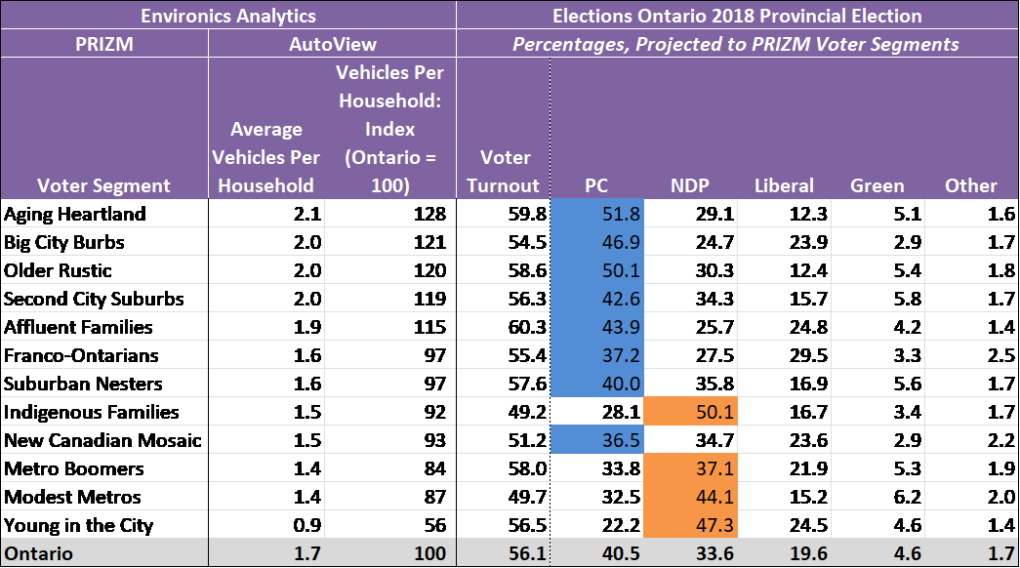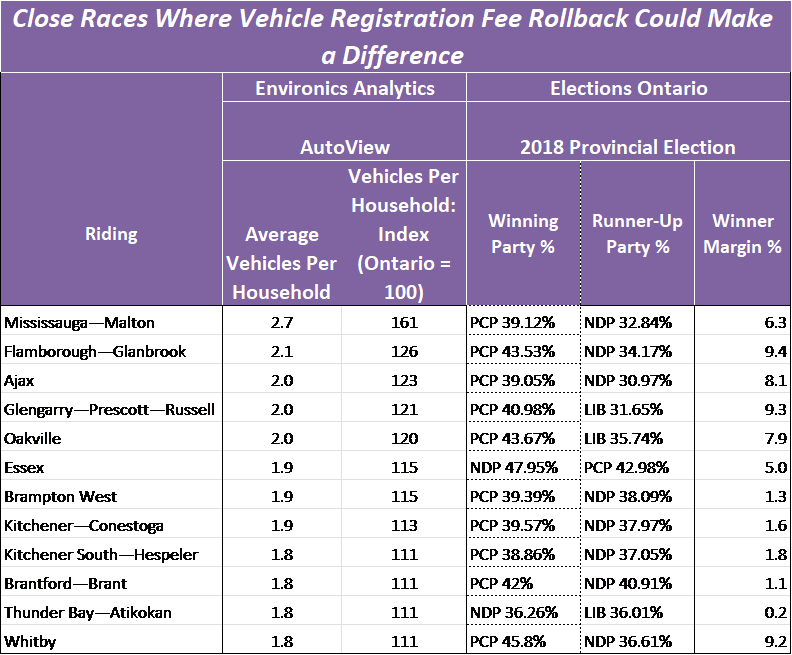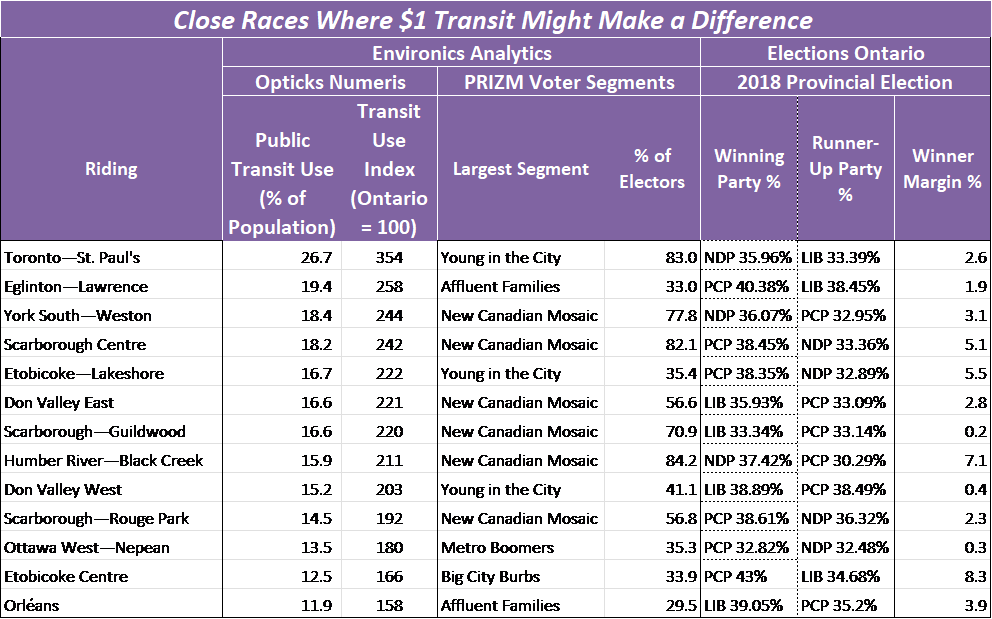Which Ontario voters are impacted by the licence plate renewal rebates?
The provincial government’s decision to scrap vehicle registration renewal fees in Ontario greatly benefits drivers living in ridings that mostly voted for the Progressive Conservatives in 2018, data suggests.
There are five voter groups with vehicle ownership rates above the provincial average—which stands at 1.7 per household. According to data by Environics Analytics, those five groups tend to favour the PCs.
“This initiative especially benefits Ontarians with higher rates of vehicle ownership because they would receive a larger refund cheque or savings on fees payable in the future,” Rupen Seoni, senior vice president of Environics Analytics, told CTV News Toronto.
“The segments that have the highest vehicle ownership also voted decisively PC.”
The voting groups are primarily made of a mix of suburban families, older couples and affluent city families.
 This table shows the average vehicle owned per household, divided into Ontario voter segments. (Environics Analytics)
This table shows the average vehicle owned per household, divided into Ontario voter segments. (Environics Analytics)
The Ontario government scrapped licence plate renewal and sticker fees for passenger vehicles, light duty trucks, motorcycles and mopeds as of March 13. Drivers who paid the fees after March 1, 2020 are entitled to a refund under this policy.
The measure will save many Ontario drivers up to $120 a year.
The Ontario's Financial Accountability Officer said the fees brought in $1.95 billion in revenue for the government in 2018-2019.
Neither the NDP, Liberals or Green Party have said they would reinstate renewal fees; however since the PCs were the party to introduce the measure, Seoni said it could give them an advantage.
“We find 12 ridings where the refund could help re-elect PC MPPs that won on thin margins or help overturn an incumbent from another party that squeaked out a win last time,” Seoni said.
“All were won by the PCs in 2018, except for two by the NDP. Most are in the GTA and southwestern Ontario.”
In all the ridings, the average vehicle ownership per household is also above the provincial average.
 These ridings could be swayed by the licence plate renewal fee rebates. (Environics Analytics)
These ridings could be swayed by the licence plate renewal fee rebates. (Environics Analytics)
On the other side, the proposed “buck-a-ride” plan put forward by the Ontario Liberal Party could help them reclaim some ridings that previously voted NDP.
“Politically speaking, the most important segments to the Liberals who would benefit from this policy is Young in the City (who voted strongly for the NDP in 2018) and New Canadian Mosaic (who swung to the PCs and NDP in almost equal measures),” Seoni said. “These are two groups that could – and have – voted Liberal in the past. This policy could help them win some votes back.”
- EXPLAINER: Who are the voter segments?
Seoni says there are 13 ridings where the rate of public transit use is at least 50 per cent above the provincial average. Eleven of those ridings are in Toronto while the remaining two are in Ottawa.
“Considering the Liberals only had seven seats at dissolution of the legislature, it’s remarkable that four of them are in this list, and they won over the PCs by under four per cent every case, so these seats are critical for them.”
 Ontario ridings where voters use transit the most and where the Liberals' "buck-a-ride" policy may impact. (Environics Analytics).
Ontario ridings where voters use transit the most and where the Liberals' "buck-a-ride" policy may impact. (Environics Analytics).
Under the Liberal plan, all transit fares in Ontario—including GO Transit—would be reduced to $1 until 2024. It is unclear what will happen to the fares after this time frame.
The Liberals say this plan would cost about about $710 million in 2022-23.
The map below shows the ridings with the voter segments that drive the most and how they voted in 2018. It also shows where voters who spend the most on transportation and own the most cars live.
Can’t see the map? Click here.
View the full-screen version of this interactive map by Esri Canada with Environics Analytics data.
Environics Analytics and CTV News are both owned by BCE Inc.
CTVNews.ca Top Stories

'Canadians deserve a real choice': Justin Trudeau resigning, prorogues Parliament
Prime Minister Justin Trudeau is stepping down as Liberal leader, and is proroguing Parliament as the Liberal Party of Canada embarks on the journey to replace him.
Trudeau resignation: recap key moments, analysis, reaction as it happened
Prime Minister Justin Trudeau has stepped down as Liberal leader. Here's a recap of key moments, analysis, and reaction as it happened.
Justin Trudeau steps down as Liberal leader. Who are the top contenders to replace him?
With Prime Minister Justin Trudeau's resignation as Liberal party leader, several well-known political faces may be waiting in the wings for their opportunity to take his place.
'Together, what a great nation it would be': Donald Trump, Elon Musk react to Justin Trudeau's resignation
Amid news of Prime Minister Justin Trudeau's resignation as leader of the Liberal party on Monday morning, reactions from prominent figures began piling in.
Justin Trudeau is resigning, what will be his legacy? A look back at key political eras
In a seismic political move, Justin Trudeau has announced his intention to step down as leader of the Liberal Party of Canada and prime minister, once his successor is named. This decision comes after more than nine years in the country's top job and nearly 12 years at the helm of his party.
Trudeau says Parliament is 'prorogued' until March. What does that mean?
In his resignation speech on Monday, Prime Minister Justin Trudeau announced that Parliament would be prorogued until March, which will give the Liberal party time to find a new leader ahead of an expected confidence vote and early election.
Justin Trudeau resignation: Here's what he said in Ottawa today
Prime Minister Justin Trudeau delivered a speech about his political future Monday morning outside Rideau Cottage in Ottawa. Here's the message he delivered to Canadians.
Alberta government signs new oil and gas agreement with Enbridge
The Alberta government has signed an agreement with Enbridge that Premier Danielle Smith says will increase exports of the province's heavy oil to the United States.
Trudeau leaves mixed global legacy as he exits during turbulent time, analysts say
Prime Minister Justin Trudeau will leave the world stage with a legacy of promoting feminist causes and focusing on Asia, along with criticism that Canada's actions fell short of the government's rhetoric.






























